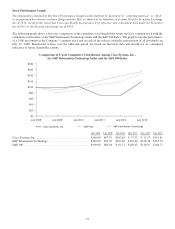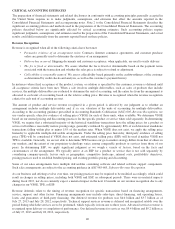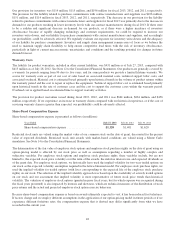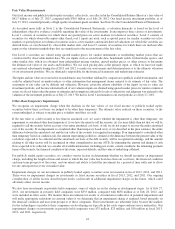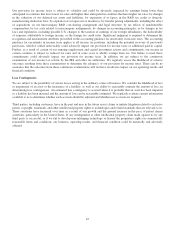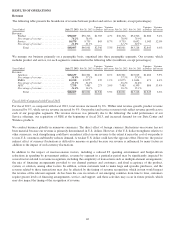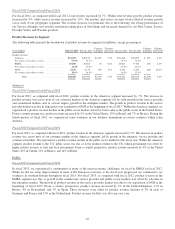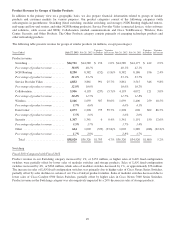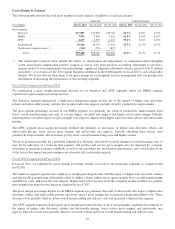Cisco 2013 Annual Report Download - page 53
Download and view the complete annual report
Please find page 53 of the 2013 Cisco annual report below. You can navigate through the pages in the report by either clicking on the pages listed below, or by using the keyword search tool below to find specific information within the annual report.Our provision for income taxes is subject to volatility and could be adversely impacted by earnings being lower than
anticipated in countries that have lower tax rates and higher than anticipated in countries that have higher tax rates; by changes
in the valuation of our deferred tax assets and liabilities; by expiration of or lapses in the R&D tax credit or domestic
manufacturing deduction laws; by expiration of or lapses in tax incentives; by transfer pricing adjustments, including the effect
of acquisitions on our intercompany R&D cost-sharing arrangement and legal structure; by tax effects of nondeductible
compensation; by tax costs related to intercompany realignments; by changes in accounting principles; or by changes in tax
laws and regulations, including possible U.S. changes to the taxation of earnings of our foreign subsidiaries, the deductibility
of expenses attributable to foreign income, or the foreign tax credit rules. Significant judgment is required to determine the
recognition and measurement attributes prescribed in the accounting guidance for uncertainty in income taxes. The accounting
guidance for uncertainty in income taxes applies to all income tax positions, including the potential recovery of previously
paid taxes, which if settled unfavorably could adversely impact our provision for income taxes or additional paid-in capital.
Further, as a result of certain of our ongoing employment and capital investment actions and commitments, our income in
certain countries is subject to reduced tax rates and in some cases is wholly exempt from tax. Our failure to meet these
commitments could adversely impact our provision for income taxes. In addition, we are subject to the continuous
examination of our income tax returns by the IRS and other tax authorities. We regularly assess the likelihood of adverse
outcomes resulting from these examinations to determine the adequacy of our provision for income taxes. There can be no
assurance that the outcomes from these continuous examinations will not have an adverse impact on our operating results and
financial condition.
Loss Contingencies
We are subject to the possibility of various losses arising in the ordinary course of business. We consider the likelihood of loss
or impairment of an asset or the incurrence of a liability, as well as our ability to reasonably estimate the amount of loss, in
determining loss contingencies. An estimated loss contingency is accrued when it is probable that an asset has been impaired
or a liability has been incurred and the amount of loss can be reasonably estimated. We regularly evaluate current information
available to us to determine whether such accruals should be adjusted and whether new accruals are required.
Third parties, including customers, have in the past and may in the future assert claims or initiate litigation related to exclusive
patent, copyright, trademark, and other intellectual property rights to technologies and related standards that are relevant to us.
These assertions have increased over time as a result of our growth and the general increase in the pace of patent claims
assertions, particularly in the United States. If any infringement or other intellectual property claim made against us by any
third party is successful, or if we fail to develop non-infringing technology or license the proprietary rights on commercially
reasonable terms and conditions, our business, operating results, and financial condition could be materially and adversely
affected.
45


